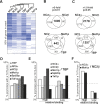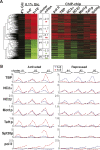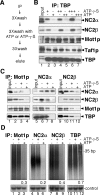Cooperative action of NC2 and Mot1p to regulate TATA-binding protein function across the genome
- PMID: 18703679
- PMCID: PMC2532931
- DOI: 10.1101/gad.1682308
Cooperative action of NC2 and Mot1p to regulate TATA-binding protein function across the genome
Abstract
Promoter recognition by TATA-binding protein (TBP) is an essential step in the initiation of RNA polymerase II (pol II) mediated transcription. Genetic and biochemical studies in yeast have shown that Mot1p and NC2 play important roles in inhibiting TBP activity. To understand how TBP activity is regulated in a genome-wide manner, we profiled the binding of TBP, NC2, Mot1p, TFIID, SAGA, and pol II across the yeast genome using chromatin immunoprecipitation (ChIP)-chip for cells in exponential growth and during reprogramming of transcription. We find that TBP, NC2, and Mot1p colocalize at transcriptionally active pol II core promoters. Relative binding of NC2alpha and Mot1p is higher at TATA promoters, whereas NC2beta has a preference for TATA-less promoters. In line with the ChIP-chip data, we isolated a stable TBP-NC2-Mot1p-DNA complex from chromatin extracts. ATP hydrolysis releases NC2 and DNA from the Mot1p-TBP complex. In vivo experiments indicate that promoter dissociation of TBP and NC2 is highly dynamic, which is dependent on Mot1p function. Based on these results, we propose that NC2 and Mot1p cooperate to dynamically restrict TBP activity on transcribed promoters.
Figures







Similar articles
-
Tight cooperation between Mot1p and NC2β in regulating genome-wide transcription, repression of transcription following heat shock induction and genetic interaction with SAGA.Nucleic Acids Res. 2012 Feb;40(3):996-1008. doi: 10.1093/nar/gkr784. Epub 2011 Oct 5. Nucleic Acids Res. 2012. PMID: 21976730 Free PMC article.
-
The NC2 repressor is dispensable in yeast mutated for the Sin4p component of the holoenzyme and plays roles similar to Mot1p in vivo.Mol Microbiol. 2000 Apr;36(1):163-73. doi: 10.1046/j.1365-2958.2000.01839.x. Mol Microbiol. 2000. PMID: 10760173
-
Roles for BTAF1 and Mot1p in dynamics of TATA-binding protein and regulation of RNA polymerase II transcription.Gene. 2003 Oct 2;315:1-13. doi: 10.1016/s0378-1119(03)00714-5. Gene. 2003. PMID: 14557059 Review.
-
Mot1 associates with transcriptionally active promoters and inhibits association of NC2 in Saccharomyces cerevisiae.Mol Cell Biol. 2002 Dec;22(23):8122-34. doi: 10.1128/MCB.22.23.8122-8134.2002. Mol Cell Biol. 2002. PMID: 12417716 Free PMC article.
-
Role of the TATA-box binding protein (TBP) and associated family members in transcription regulation.Gene. 2022 Jul 30;833:146581. doi: 10.1016/j.gene.2022.146581. Epub 2022 May 18. Gene. 2022. PMID: 35597524 Review.
Cited by
-
Aspergillus fumigatus Transcription Factors Involved in the Caspofungin Paradoxical Effect.mBio. 2020 Jun 16;11(3):e00816-20. doi: 10.1128/mBio.00816-20. mBio. 2020. PMID: 32546620 Free PMC article.
-
Defects in the NC2 repressor affect both canonical and non-coding RNA polymerase II transcription initiation in yeast.BMC Genomics. 2016 Mar 3;17:183. doi: 10.1186/s12864-016-2536-2. BMC Genomics. 2016. PMID: 26939779 Free PMC article.
-
Low overlap of transcription factor DNA binding and regulatory targets.Nature. 2025 Jun;642(8068):796-804. doi: 10.1038/s41586-025-08916-0. Epub 2025 Apr 16. Nature. 2025. PMID: 40240607
-
Structural basis for recognition and remodeling of the TBP:DNA:NC2 complex by Mot1.Elife. 2015 Aug 10;4:e07432. doi: 10.7554/eLife.07432. Elife. 2015. PMID: 26258880 Free PMC article.
-
Identification of Three Sequence Motifs in the Transcription Termination Factor Sen1 that Mediate Direct Interactions with Nrd1.Structure. 2019 Jul 2;27(7):1156-1161.e4. doi: 10.1016/j.str.2019.04.005. Epub 2019 May 16. Structure. 2019. PMID: 31104813 Free PMC article.
References
-
- Auble D.T., Hansen K.E., Mueller C.G., Lane W.S., Thorner J., Hahn S. Mot1, a global repressor of RNA polymerase II transcription, inhibits TBP binding to DNA by an ATP-dependent mechanism. Genes & Dev. 1994;8:1920–1934. - PubMed
-
- Basehoar A.D., Zanton S.J., Pugh B.F. Identification and distinct regulation of yeast TATA box-containing genes. Cell. 2004;116:699–709. - PubMed
-
- Blake W.J., Balazsi G., Kohanski M.A., Isaacs F.J., Murphy K.F., Kuang Y., Cantor C.R., Walt D.R., Collins J.J. Phenotypic consequences of promoter-mediated transcriptional noise. Mol. Cell. 2006;24:853–865. - PubMed
Publication types
MeSH terms
Substances
LinkOut - more resources
Full Text Sources
Molecular Biology Databases
